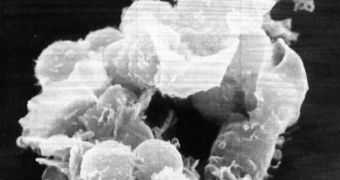There is an intensive hunt for finding what's behind the memory, the very chemical of the recalling. Now a team at Georgia Institute of Technology has found some molecular interactions on cell surfaces that could work like the "memory", changing the way the cells will interact in the future. The paper has been published on October 29 in the journal Proceedings of the National Academy of Sciences.
Sequentially repeated tests aimed to get statistical samples of molecular traits are based on the assumption that each test is the same as (while being independent of) any other tests in the sequence. But the new research shows that test sequences may not be made of independent and identically-distributed (i.i.d.) random variables. "If you are probing a cell to get a bit of information, how do you know that the cell is not going to respond by changing the information it reveals the next time you probe it? If you are probing a molecule, can you assume that the molecule will return to its original configuration before you test it the next time? We didn't think about this until we had been doing these kinds of experiments for more than ten years.", said Cheng Zhu, a Regents' Professor in the Coulter Department of Biomedical Engineering at Georgia Tech and Emory University.
The team proved that some cells can "recall" their previous encounters through receptor-ligand interactions, pointing to the fact that some sequential results may not be quite independent. "People doing research in this area ought to look at what we have found to see if their systems also have memories that may have affected their conclusions. They may discover new aspects that may have been overlooked.", said Zhu.
Receptor-ligand interactions were investigated through micropipette adhesion frequency assay. The sequence data analysis came with examples proving that interactions seen in one test changed the result of a future test, and connected to the biological system, the induced "memory" either increased or reduced the probability of a future interaction.
E.g., T-cell receptors interact with an antigen bound to major histocompatibility molecules in a positive correlation, one contact increasing the probability of a future one. Interaction between C-adherins was negatively correlated, one interaction decreasing the probability of a future one.
In some systems, the events proved to be really independent, previous interactions not biasing future ones. "The i.i.d. assumption in single-molecule experiments was something that people usually took for granted. Positive memory increases the likelihood of having two interactions in a row, which generates long strings of interactions. The negative memory, conversely, decreases the likelihood of having consecutive interactions, which results in more solitary interactions in the sequence.", said co-author Veronika Zarnitsyna, a research scientist in the Coulter Department.
The next goal of the team is to assess how long the memory effect lasts and its biological mechanisms. "It seems reasonable that if you prolong the cycle time - the period between trials - the cell or molecule would gradually forget. We believe this phenomenon may be biologically important, though we don't yet know the implications for it. This may represent a way for cells to regulate their adhesion and signaling. For T cells, the ability to 'remember' even a brief interaction with a pathogen may be related to their ability to tell an intruder from "self" molecules, which is crucial to the body's defense in the immune system.", Zhu added.

 14 DAY TRIAL //
14 DAY TRIAL //